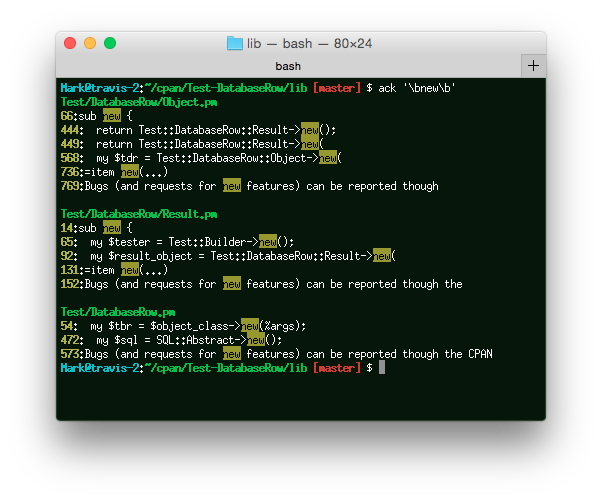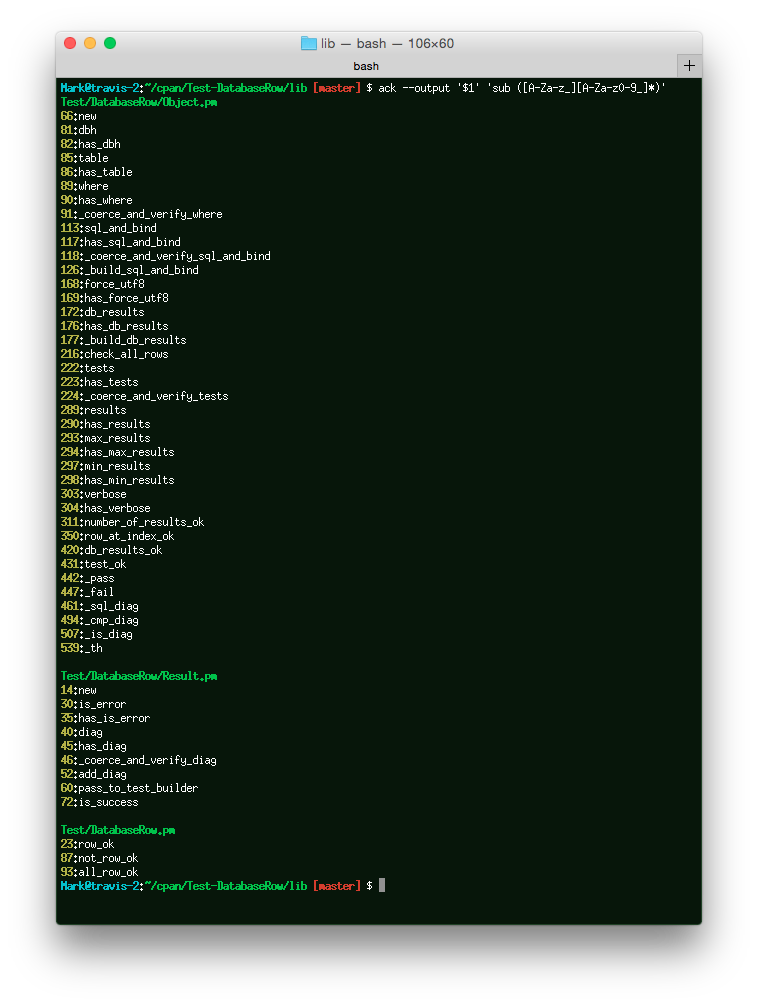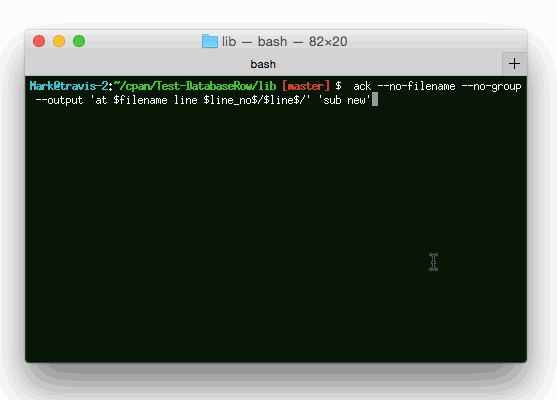Beyond Grep
Ack is a Perl based command line utility designed to replace "99% uses of grep" which is a fancy way of saying it's a much smarter version of grep designed to be used at the command line interactively rather than in scripts.
The Advantages of Ack
Whenever I get started on a big new project I need to familiarize myself with the codebase. Typical questions I tend to ask are:
- Where are the Perl source files? The JavaScript? The HTML, etc?
- What files are using this subroutine? Where is this method defined?
I used to use grep -r to help me with this. But I always found it was searching in the wrong places (Inside my version control files...in big log files and images rather than inside the Perl modules...) And even when it did find the thing I was looking for in files I'd end up staring at the output trying to work out exactly where the bit of the string that matched was.
Then I discovered ack. And my life became a lot easier.

At its most basic ack can be thought of a version of grep that does the right things by default. These include:
- Highlighting the matched text
- Automatically ignoring common version control, scratch, and temporary files.
- Searching recusively in the current directory by default when a filename isn't passed and it's not being used in a pipe.
- Showling clearly both filenames and line numbers of each match (and optionally column numbers)
- Easily allowing restrictions to seaching particlar types of files
- Using Perl's powerful regular expression engine
Or to put it another way, this grep:
grep --exclude-dir .git \
--include *.pl \
--include *.pm \
--include *.pod \
--include *.t \
--include *.psgi \
-r -n -E '(foo|bar)' .Could be better written as this ack:
ack --perl '(foo|bar)'(And ack will also do highlighting of match and group matches within a file together in a readable form!)
Ack file types
One of the great advantages in using ack is that ability to only search files that of a particular type. In addition to the large range of built in types you can easily add a specification for your own types to ack or modify existing files by using extra command line arguments.
For example, several places I have worked have had their own template system that can contain embedded Perl code, but because these files don't use the standard Perl extensions of .pl,.pm,.pod, .t, or .psgi, nor start with a perl shebang line, ack invoked with --perl won't search them. I'd like ack to search within the .perlt files also. This can be done by adding another option to ack:
ack --type-add=perl:ext:perlt --perl fooOf course typing this every time I ran ack would be extremely tiresome. For this reason I copy this arguments into my .ackrc where ack reads them in each time ack is invoked so I always have my perlt search available.
echo '--type-add=perl:ext:perlt' >> ~/.ackrc
ack --perl fooWe're not limited to file extensions here; For example, I can tell ack that any file that starts with { on the first line should be considered JSON:
ack '--type-add=json:firstlinematch:/^\s*\{/' --json fooAck power use
The above should probably be enough to convince you to switch to using ack on a day to day basis for interactive file grepping. But what about some of the really crazy powerful things you can do with ack?
Find all files of a particular type
ack is pretty smart about working out what files it should ignore, including things like version control files, editor backup files, and even things like minified versions of JavaScript.
This makes it a good choice for simply getting a list of particular files of a given type in a project:
# find all un-minified JavaScript files in your file tree
ack -f --js
bootstrap/js/bootstrap.js
js/main.js
js/jquery.js(This uses -f to just print the filename that would be searched rather than actually searching the file and --js to specify that we want JavaScript extensions)
Once you've got a list of files like this you can start doing interesting things with them by using utilities like xargs:
# delete all php code!
ack -f --php --print0 | xargs -0 rm -fThis works the same as the previous example but uses the --print0 argument to ack and -0 argument to xargs (so that the two communicate the filenames across the pipe delimited by a null character rather than whitespace preventing problems with filenames with whitespace in their names.)
Replacing -f with -l means we will also search the files with our passed regex, and only list those files that match (but not show how we match like in traditional output.) Combining this with xargs again we can do even more powerful things:
# commit all the code that have "use strict"
bash$ ack -l --perl --print0 'use strict' | xargs -0 git add
bash$ git commit -m 'add strictures'Using ack to highlight things in a file
ack can be used just to highlight a string in a file. For example, everywhere that $jolly is used:
ack --passthru -Q '$jolly' lib/Santa.pm The --passthru option tells ack to display all lines, matching or not. The -Q tells ack to treat the string we're highlighting as a literal pattern rather than a regexp.
We can even use this technique in a tail. For example to highlight the string "Error" in our logfile:
tail -n0 -f /tmp/log | ack --passthru Error
Custom Output
Ack allows you to modify the output from the default matching line with match highlighted output to something custom. If we want to get a list of all the subroutines in our file tree we can easily do that: We search for all the sub something but only display the something not the leading sub. By using --output we can pass a Perl string that ack will eval after each match and use the result for the output:

With a little imagination this can be used to very powerful things. For example, the size of the URLs mentioned in a file:
ack --output='$&: @{[ eval "use LWP::Simple; 1" && length LWP::Simple::get($&) ]} bytes' \
'https?://\S+' list.txt
http://google.com/: 19529 bytes
http://metacpan.org/: 7560 bytes
http://www.perladvent.org/: 5562 bytesHowever the smartest thing I've ever used the custom output for is to generate lines that look just like Perl error messages:
ack --no-filename --no-group \
--output 'at $filename line $line_no$/$line$/' \
'sub new'Why is this so helpful? Because I use the PerlErrorSublime.popclipext PopClip extension to allow me to highlight any perl-error like string in my terminal and open that line in Sublime Text:

Conclusion
Hopefully I've convinced you now not only that ack can be used as a basic replacement for grep, but also there's some very formidable things you can do with it if you take a little time to learn some of the more powerful options.